Plants with Purpose
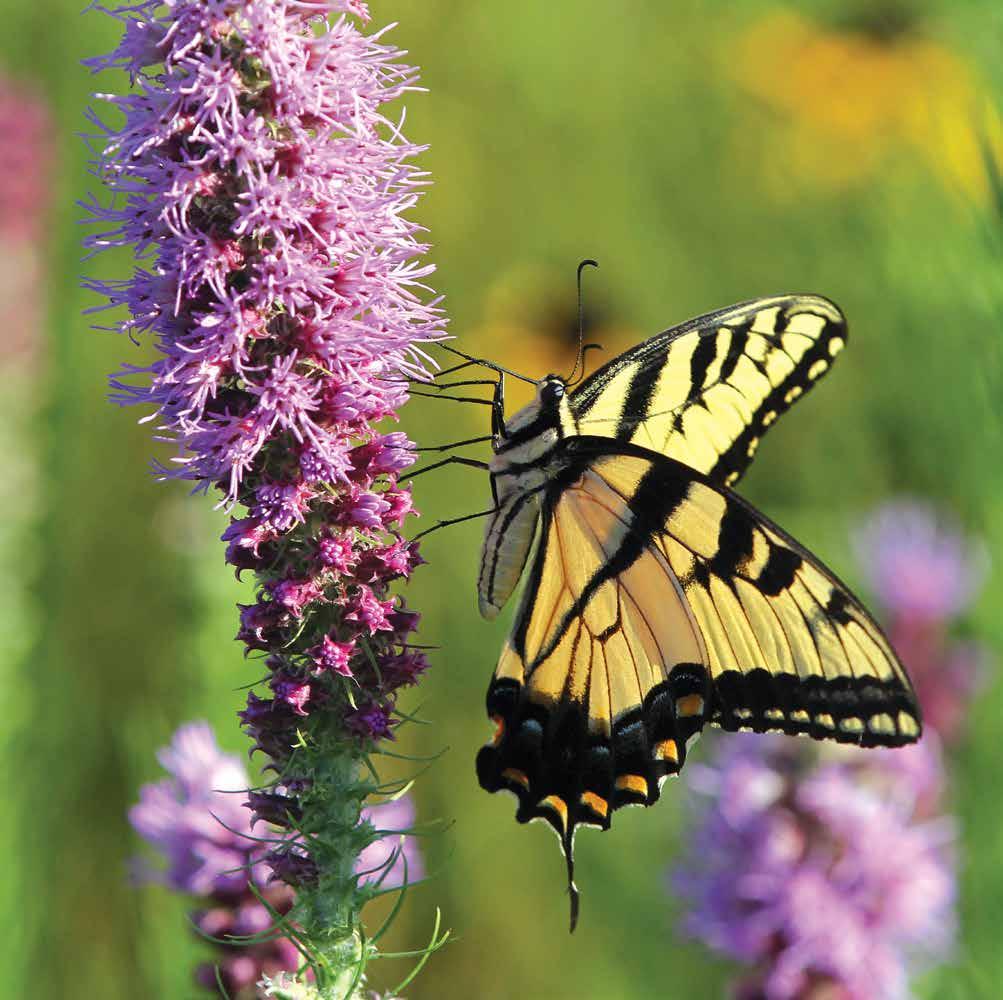
March 2023 | kcgmag.com
City
GARDENER The Kansas
Vultures, Swallows & Buntings, Oh My! | Migrants and Residents Rose Report | Indoor Gardening | When a Rose isn’t Just Another Rose
The Kansas City
Independently owned and operated since 1996
PUBLISHER
Michael Cavanaugh
EDITOR
Elizabeth Cavanaugh
CONTRIBUTORS
Jerry Dreyer
Lenora Larson
Jason Mispagel
Dennis Patton
Elizabeth Stoakes
Denise Sullivan
Mervin Wallace
Scott Woodbury
DISTRIBUTION Publishers Delivery Solutions, Inc.

IF YOU WOULD LIKE TO DISTRIBUTE the magazine at your place of business, please contact Mike Cavanaugh at mike@kcgmag.com
913-648-4728
NEED MORE MAGAZINES? mike@kcgmag.com
913-648-4728
CONTACT US
P.O. Box 8725 Prairie Village, KS 66208
913-648-4728
ADVERTISING
Mike Cavanaugh at mike@kcgmag.com
913-648-4728
EDITORIAL
Elizabeth Cavanaugh elizabeth@kcgmag.com
913-648-4728
HOW TO SUBSCRIBE
See details on page 27.
SUBSCRIPTION
Elizabeth Cavanaugh elizabeth@kcgmag.com


913-648-4728
WEBSITE kcgmag.com
Garden musings
Gardeners are grateful for sunny winter days. When the sun shines on the garden, it is an invitation to stroll, discover and dream. While warmed by the sunlight, we refresh our memory of our plans for the garden, and envision what the landscape will present in coming months. We imagine the stores of energy beneath the layer of mulch and soil awaiting a signal to awaken. And when the time is right we, too, will unleash our stores of energy toward another growing season.
One of those wonderfully warm winter mornings had me lingering a bit longer. With the sun flooding the living room, the cats were laid out on the floor basking in a few moments of peaceful coexistence. In a strange paradox, I sat with coffee in hand facing the window that looks out over the garden to watch the birds. The robins pluck fruit from the crabapple tree, and the cardinals sit perched announcing the morning news. Honestly, I’m glad the cats are dozing.
Also in plain view is the debris field caused by recent winter winds. Large birch and oak tree branches lay across the pathways (an obstacle for the mail carrier) and jut out of the boxwood border and the upright junipers like spears.
I need to collect them for the fire pit. It seems I’ve left them laying too long. Where does the time go?
The first day of spring arrives this month—Monday, March 20. Of course, winter will likely control the temperatures for a few more weeks. The heavy winter coat and gloves are still handy. However, the promise of spring is remains. That promise offers numerous activities for gardeners, novice and experts alike. From plant sales and workshops, to symposiums and garden shows, there is much to enjoy. All evidenced in this issue; notice the ads and editorial that mention scheduled gatherings. It feels good to get back to a full Upcoming Events section (see page 22).
There is so much to choose from, and personally I would love to participate in everything. My planner stays full with business and personal commitments. Thus I must be cautious about overextending myself.
One treasured meeting on my calendar is rarely missed—a standing coffee date with a dear, dear friend. Once a month we talk about everything under the sun, and over the moon, as much as we can squeeze in for an hour.
The topic of gardening is shortlived. When asked, she responds,

“For about 15 minutes in spring when everything in the landscape is beautiful—that’s how much time I give to gardening.” Her husband loves the hedge clippers, and the yews reflect his tabletop precision. This makes me laugh. I would not miss coffee with her. Even though gardening isn’t at the center of our bond, our friendship goes beyond the ephemera of coffee and current events. It is deeper and richer with unconditional acceptance of who we are as humans making our way on this planet one day at a time.
I’ll see you in the garden!
2023 | kcgmag.com
About the cover: Prairie blazing star and tiger swallowtail butterfly, photo by Pat Westhoff. Pat and her husband, Tom, first planted native wildflowers and grasses on their farm in 1991. That’s 31 years of enjoying the plantings and the birds, butterflies, and more that claim the area as home.
2 March
editor’s notes
GARDENER
In this issue March 2023 | kcgmag.com 4 Ask the Experts 6 Vultures, Swallows & Buntings, Oh My! 8 Plants on Your Plate—Herbs & Spices 10 When a Rose isn’t Just Another Rose 12 Migrants and Residents 14 More Than a Pretty Face 16 Rose Report 18 Our New Pond 20 Indoor Gardening: The Whole Plant 22 Upcoming Garden Events 24 Healthy Yards Expo 26 Garden Calendar 27 Subscribe 27 Hotlines
Finally, a foolproof bloomer! Let’s Dance Can Do! hydrangea is an extra-hardy hybrid that blooms even if it’s cut back, damaged by cold, or dined upon by deer. Its full, lacecap flowers are very showy and cover the shrub from top to bottom, all season long.
Look for Let’s Dance Can Do! hydrangea in the distinctive white Proven Winners® container at your local garden center, or learn



The Kansas City Gardener | March 2023 3
DANCE CAN DO! ® Hydrangea
LET’S
TRIALED & TESTED FOR YOUR SUCCESS
more at ProvenWinnersColorChoice.com
TO LEARN MORE
SCAN
MOVING ME AND MY PLANTS OUT OF STATE
Question: I am relocating to another state and want to take several of my favorite perennials with me. What is the best way to pot them up and help them to survive?
Answer: I am sorry that you are leaving the KC area. Are you moving to a climate that is like ours? If you are moving south and winters lack a freezing period, your perennials may not survive. For example, peonies do not grow in the deep south. Many need a cold or rest period to bloom.
The best way to transport your perennials is to pot up like you would be purchasing. Use quality potting soil, not soil from the garden, which is heavy and may not drain, leading to root rots. Take minor, manageable divisions. Care for much like any potted plant until ready to plant. Potted perennials can be held this way for months.
It does not matter what time of year you pot up. Digging in summer is more complex than when dormant or in the spring. If you need to hold it over the winter, leave it outdoors in a protected location and mulch in with a layer of straw or leaves.
I hope this helps, and best of luck in your new home.
OAK DEADWOOD DROPPING
Question: I have a 50-yearold oak tree that is dropping dead branches. The tree looks healthy during the summer. Do I need to remove the tree?
Answer: My hunch is there is a large amount of deadwood in the tree canopy from natural causes such as shading. Since you indicate the tree looks healthy during the summer, I suggest hiring a service to come in and remove the deadwood and other corrective pruning cuts.
Looking up at any mature tree, you will notice many dead limbs and twigs. The intergrowth of the tree is shaded by the canopy, lim-

Ask the Experts
iting sunlight. The branches naturally die off. Old decaying wood is weak and eventually will fall off. This is natural as it happens in the forest all the time.
FERTILIZED AND THE RAIN NEVER CAME
Question: How long does fertilizer last once applied? I applied, hoping for rain, and it never came for a week or two.
Answer: I have not given my patent “it depends” answer for some time. Fertilizers are manufactured in many ways. Some are formulated to release immediately, while others are encapsulated to
with fertilizer. They can be unstable, and the nutrients can quickly be broken down by sunlight, morning dew, and temperature. The best recommendation is to time all applications which need to move into the soil with irrigation or natural rainfall.
PEACE LILY NEEDS ENCOURAGEMENT TO BLOOM
Question: I have had a Peace lily houseplant for a few years, and it never blooms. Do you have any tips to get this plant to send up the pretty white flowers?
Answer: Peace lily or Spathiphyllum is a popular houseplant
bound. The key to flowering is all about the amount of light. While it will tolerate low light levels, flowering is best achieved with better light conditions. Bright light, or a sunny window should stimulate sporadic flowering.
HOW TO GROW BIG BROCCOLI

Question: What is the secret to growing nice broccoli? I see people posting online these nice big heads while mine are small.
Answer: There are three keys to growing nice broccoli in the garden. One, planting at the correct time. Two, using a shorter season variety. Three, proper fertilization. Broccoli should be planted as a transplant. Depending on the season, it should be planted between mid-March and the end of March. Select healthy transplants and avoid overgrown and stressed plants, as they may never develop a nice head. The plant needs to be established before the late spring heat arrives. Planting into April does not allow enough time for the plant to develop before the heat arrives. This plant likes long, cooler springs.
break down over time. These methods of release are once they are moved into the soil based on water and microbial activity.
Your question is about before moving into the soil. Again, it depends on the formulation. The best recommendation is for water to move into the ground within 24 to 48 hours. Again, it depends on the fertilizer analysis and how the particles are coated. The other best answer is to read the label for the manufacturer’s recommendations. It also depends on if there are other products in the fertilizer. Herbicides and insecticides can be mixed
as it tolerates low light levels in the home. It is prized for its strapping green leaves and occasionally white flowers. Many think it’s a funeral plant as it is often given in memory of a loved one.
Peace lilies do best with excellent drainage and even moisture. Uneven moisture can cause leaves to turn yellow. The plant often has brown leaf tips due to low humidity. Fertilize during the spring and summer and withhold during fall and winter as the light levels decrease.
Flowering is best achieved when the plant is slightly root
Varieties for the KC area include should mature between 50 and 70 days. Longer days to maturity may succumb to hot summer weather. Recommended varieties include Diplomat, Green Comet, Gypsy, Imperial, Packman, and Premium Crop.
A large head requires a big green leafy plant to produce enough energy to support a dinner plate head. Fertilize before planting, water in with a transplant solution, and then sprinkle a little fertilizer around each plant every two to three weeks. Nitrogen is the nutrient needed in the greatest quantities. Use a teaspoon or so per plant sprinkled out and around each plant. Keep evenly moist. You really cannot over-fertilize broccoli. It would be best if you harvested sometime in mid to late May.
4 March 2023 | kcgmag.com
DENNIS PATTON Horticulture Agent Dennis Patton is the horticulture agent for Johnson County K-State Research and Extension. For free information fact sheets, visit www.johnson.ksu.edu, or call the Extension office at 913-715-7000.
To grow big broccoli start with planting a healthy transplant.

The Kansas City Gardener | March 2023 5
Vultures, Swallows, & Buntings, Oh My!
When March and April weather is less than stellar, our changing cast of birds, finding their voices and sporting breeding plumage, reminds us that winter won’t last forever. Spring is a time of wonder for humans and frantic activity for birds as they prepare to nest and raise young. Spring migration is a “race to the finish,” accomplished in weeks rather than the leisurely southward movement of fall months. Males often migrate ahead of their future mates, to secure prime breeding territories. For example, Red-winged blackbirds are always present, but numbers increase exponentially in spring. Winter males that calmly shared seed at feeders turn quarrelsome, making harsh onk-a-ree calls and flashing their glossy red and yellow epaulets in defensive displays. Some pass quickly to nest farther north; local breeders establish territories near water and await females. Female red-wings are brown, heavily camouflaged with dark streaks; if noticed, they are often mistaken for a different species! Even in urban areas, almost every pond, lake, or grassy field will host these intriguing birds. The female attaches a cup-shaped nest to tall vegetation; once she hatches the eggs, both parents feed the young, often producing two broods per season.
Traditionally, robins and bluebirds were considered harbingers of spring, but Christmas Bird Count data confirms that these thrush family cousins remain all year, leaving only if food is scarce or weather is severe. They’re simply more conspicuous as they resume singing and courtship activities. Bluebird houses should be ready by the first week of March; these enthusiastic breeders may nest three times in a season!
Birders happily award our “Bird of Spring” title to the Turkey Vulture (looks aren’t everything)! Remember to glance up occasionally during seasonal garden chores and

you’ll almost certainly spot these large dark carrion-eaters (with pale wing linings) effortlessly gliding and circling within warm air columns (thermals) on sunny days. Vultures return to our skies by early to mid-March after spending the winter only a few hundred miles south, with their smaller Black Vulture relatives.
When “TVs” arrive, swallows and flycatchers aren’t far behind! Most of these insect-eaters winter in Central and South America. Purple Martins appear earliest, after journeying from Brazil—their houses should be opened by March 12. Young birds arrive first, to establish new colonies; older birds generally reuse former nesting areas. Iridescent Tree Swallows soon follow; near water, they often compete aggressively for bluebird houses.
Eastern Phoebes visit yards, especially near woodland edges. These agile bluebird-sized flycatchers, grayish brown with pale bellies, are recognized by their long, constantly bobbing tails. Listen for their distinctive fee-bee calls. Phoebes typically swoop from a perch
ELIZABETH STOAKES

Birding Enthusiast
and snatch insects from the air (“hawking”), returning to their initial roost to eat. Especially fond of butterflies, moths, and dragonflies, they also glean small insects from foliage. By “leaving the leaves”, you’ll help nourish these early migrants!
Winter sparrows slip away unnoticed during April and early May. Most migrate at night, to breed in the woodlands of Canada. Whitethroated Sparrows refuse to go quietly, practicing their melodious songs before departure. If you hear a clear Old Sam Peabody-PeabodyPeabody, you’ll know at least one winter bird remains in the bush!
Late April heralds the arrival of hummingbirds, orioles, and gorgeous Indigo Buntings. These sparrow-sized Cardinal relatives eat an omnivorous diet, including feeder fare. Males display rich blue coloration, without blue pigments! Their color is “structural”, created entirely by light reflected from their feathers. Brown females are inconspicuous as they tend their nests in dense, low shrubs. Males perch in the open and sing their loud sweetsweet-chewy-chewy songs fre-
quently, even on hot days.
How can we support and protect birds during this strenuous, hazardous, and challenging season?

• Leave feeders in place to provide “refueling stops” for migrants and early nesters.
• Mitigate window collision hazards. Parachute-cord “Wind Curtains”, semi-transparent “bird tape”, painter’s tape, one-way window films, and washable markers are some options to make windows more visible to birds.
• Close curtains/shades and turn off outdoor lights at night to avoid attracting and disorienting nocturnal migrants.
• Leave brush piles in place.
• Delay removal of leaves and plant debris until the end of April to help insects as well as birds.
For more information, please visit Cornell University’s excellent bird guide at allaboutbirds.org. You’ll find photos, sound recordings, range maps, and life histories of every North American species. See how many new species you can spot as spring progresses!
6 March 2023 | kcgmag.com
Left: An Indigo Bunting’s blue color is an “optical illusion.”
Right: Turkey Vultures return in March to resume clean-up chores.
Elizabeth Stoakes is currently President of Burroughs Audubon Society in Kansas City and has been birding for over 25 years. Please contact BAS via mail@burroughs.org or text/call 816-795-8177 with any birding questions.
Photos by Ron Billinger.

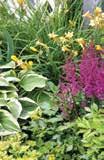





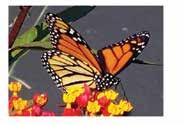
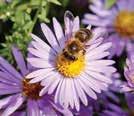



The Kansas City Gardener | March 2023 7 7130 Troost, Kansas City, Mo. www.soilservice.com 816-444-3403 Landscape Design, Installation and Maintenance Services From trees and shrubs to perennials, mulch and stone, expert Landscape Designers are ready to help with your next project! Call today for an At-Home Consultation. April 27, 28, & 29 2023 Thursday 9:00 - 5:00 Friday 9:00 - 6:00 Saturday 9:00 - 1:00 Opens Daily at 9:00 am Paola Plant Sale 913 N. Pearl, Paola, KS, 66071 The sale will be held in the parking lot of the Extension Offices located at 913 N. Pearl, (Old K1C Road) Paola, KS Pesticide-free, Locally Grown! More Butterfly Host Plants than ever! Native Plants Pollinator Plants Herbs Annuals Perennials Veggies Succulents Hanging Baskets Trees Hypertufa Gifts! Master Gardener Marais de Cygnes District Cash, Credit Cards & Checks Accepted Sponsored by: Koi Pond and Water Feature Designs Wendy Hix • 913.481.5416 Tate Foster • 913.406.6804 www.hixandsonaquatics.com New Installations, Remodels Upgrades, Repairs and Maintenance Services
PLANTS ON YOUR PLATE Herbs and Spices

climates, hence, most of the spices we use are in dried form. Herbs, however, are widely available in both fresh and dried from. Herbs are also simple to grow, both indoors and outdoors.
For information on growing your own herbs, MU Extension has a publication available here: http:// bit.ly/3l97YKA
One of the biggest questions that people have when starting or expanding their culinary use of herbs and spices is ‘what flavors go
with what foods?’ While taste is a very personal thing, our colleagues at Arizona Extension have an excellent publication called Season for Health that gives some excellent suggestions; you can find it here: http://bit.ly/3DzLLvh
If you have eaten Mediterranean style food, you may be familiar with a salad known as Tabbouleh. The recipe below is a favorite at my house. Fresh parsley and mint are used in abundant quantities for flavor as well as bulk.
Bulgur Wheat Salad
MAKES 6 SERVINGS
INGREDIENTS
As I open my computer to prepare for my monthly column, I sometimes find myself struggling to think of a topic that I haven’t already discussed. That’s not to say that repetition is a bad thing…we typically need to say or do things more than once for them to become a habit. With a new vegetable or fruit, we also need repeated exposure and experiences. If we didn’t like the way something was prepared, a different recipe or preparation method might increase the appeal. This month, I have decided to focus on how herbs and spices can enhance your mealtime experience.
Though we tend to say herbs and spices in one breath, botanically speaking, herbs are leafy and plantlike, while spices come from the roots, buds, seeds, berries or fruits of plants or trees. Some plants produce both herbs and spices, like dill which produces both dill week and dill seed; and cilantro which produces the herb used in southwest cuisine and the dried seed known as coriander.
While herbs and spices are widely known for their culinary
uses, they are also known for their cultural and economic roles in history. Spices in particular were valued for monetary and trade values when European and far eastern travel routes expanded. Both herbs and spices have also been important in healing and cultural rituals for centuries. Recent science has revealed that there indeed are specific health benefits for a great many herbs and spices.
One of the primary health benefits of incorporating more herbs and spices into culinary use comes from reducing excess salt and sodium. Simply replacing some or all of the salt with a complementary herb or spice in food preparation can have positive effects on high blood pressure, a condition affecting almost half of adults in America. Other spices, like ginger and turmeric can help with inflammation that accompanies many chronic health conditions. As with all plants, herbs and spices contribute a variety of phytonutrients that function as antioxidants, which can help prevent diseases like heart disease and cancer.
Spices tend to grow in tropical
DENISE SULLIVAN Nutrition Ninja

½ cup bulgur wheat
1 cup boiling water
1 teaspoon za’atar seasoning*
2 cups flat leaf parsley, chopped
½ cup mint, chopped
2 tomatoes, seeded and chopped
1 English cucumber, seeded, and chopped
2 green onions, finely chopped
3 Tablespoons olive oil
¼ cup lemon juice
Salt and pepper to taste
DIRECTIONS
Place the bulgur in a large bowl with za’atar and add the boiling water. Stir to combine and cover. Set aside for 20 minutes. Combine all other ingredients in another large bowl. Fluff the bulgur with a fork and drain any excess water, add to vegetables.
Adjust seasoning by adding more lemon, salt, or pepper as needed. Refrigerate and serve cold.
* Zaatar is a blend of dried herbs often including thyme, oregano, marjoram, sumac, toasted sesame seeds, pepper flakes and salt.
NUTRITION INFORMATION
Calories: 120, Total Fat: 7g, Saturated Fat: 1g, Sodium: 20mg, Carbohydrates: 13g, Fiber: 2g, Protein: 3g
Recipe from North Carolina Extension Med Instead of Meds, analyzed by verywellfit.com.
Denise Sullivan (@MUExtJacksonCo) is a Nutrition and Health Education Specialist for MU Extension in the Urban West Region, serving Jackson and Platte Counties. For research based nutrition and food safety information and programs, call 816-482-5850 or visit https://extension2.missouri.edu/.
8 March 2023 | kcgmag.com
The Rush is on!

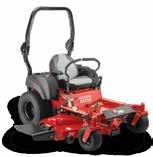


Northland Feed
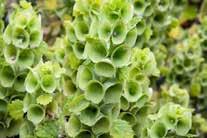







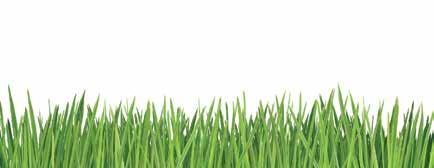

The Kansas City Gardener | March 2023 9 One free, easy call gets your utility lines marked AND helps protect you from injury and expense. Safe Digging Is No Accident: “Always Call Before You Dig in Kansas” Call 811, 1-800-DIG-SAFE, (800-344-7233) or visit us at www.kansas811.com.
wait any longer to get your equipment in for a Spring tune up. Tune ups include changing the oil and filter, replace spark plug, air filter, and sharpening blades. All equipment is assembled and ready to use when you buy it. Nothing goes out of here in a box! Authorized service center for most major manufacturers.
4807 N. Brighton, KCMO • www.mowerpartskc.com 816-452-8393 • Mon.-Fri. 9am-6pm • Sat. 9am-1pm Closed for lunch Mon.-Fri. 12:45-1:30pm Serving the Northland for 45 years Commercial Trimmers, Backpack Blowers and zero turns! We carry feed, pet supplies, and lawn and garden supplies! Mowing • Trimming Planting • Mulching Seeding • Aeration Fertilization • Clean Up Barclay Berberian 913-208-5941 LawnsByBarclay.com (913) 703-7229 • threebeeskck.com 925 Southwest Blvd, KC KS • Hours 8a-6p Tues-Sat Across from Strasser Hardware Talavera Pottery Handmade Tamales Coffee and Specialty Drinks For Home and Garden... Euston Hardware 6955 Tomahawk Rd Prairie Village, KS 66208 (913) 262-1405 Euston Hardware 453 E Red Bridge Rd Kansas City, MO 64131 (816) 216-7197 Packs Hardware 116 N 169 Highway Smithville, MO 64089 (816)
EUSTON
Don’t
532-0525
When a Rose isn’t Just Another Rose
It’s clear to me that some plants attract more insects than others. Blazing star (Liatris) and mountain mint (Pycnanthemum) are clamoring with pollinators when they are in bloom. So are Joe Pye (Eutrochium), iron plant (Vernonia), sunflower (Helianthus), and black-eyed Susan (Rudbeckia). Black gum (Nyssa sylvatica), linden (Tilia), Virginia creeper (Parthenocissus quinquefolia), and willow (Salix) are audible when in bloom, because they’re covered with clouds of buzzing bees. Milkweed (Asclepias) and spikenard (Aralia racemosa) are not only covered in pollinators, but also sugar-gathering ants and predators like jumping and crab spiders, who linger for a chance to ambush a pollinator for lunch. These native plants provide nectar and pollen “superfood” for insects.

You can see for yourself how insects will flock to your home landscaping by adding native plants and spending time looking at them. But be sure to include topperforming superfoods for insects in your home garden—not just pollen and nectar for adult insects, but also “foliage food” for insect larvae. Here’s what scientists say are the best performers.

In recent decades, Doug Tallamy and Kimberly Shropshire, entomologists at the University of Delaware, have been recording butterfly and moth interactions with native plants. It turns out that some native plants are far better at feeding caterpillars than others. Tallamy calls them keystone plants. Wherever they looked, about 5% of native plant genera were responsible for feeding about 70% of butterflies and moths. For instance, yellowwood (Cladrastis kentuckea) has no record of caterpillars feeding
on it, while oak (Quercus) has 429 species on record for our region. Cherry and plum (Prunus) have 318, willow (Salix) 257, birch (Betula nigra) 251, maple (Acer) 235, pine (Pinus echinata) 154, and rose (Rosa) has 98. For perennials, goldenrod (Solidago) tops the list with 97, sunflower (Helianthus) 73, wild strawberry (Fragaria virginiana) 59, leadplant (Amorpha) 32, Joe Pye (Eutrochium) 30, and geranium (Geranium maculatum) 23. The full list of keystone plants is available online at Native Plant Finder (National Wildlife Federation) and Plants for Birds (Audubon Society).
Unfortunately, not all keystone species work well in the average home landscape. Black willow (Salix nigra) for instance, is an aggressive spreading plant, but luckily, prairie willow (Salix humilus) is not. It’s the most compact native willow, averaging 5 feet tall, and available in nurseries. I’ve found cliff (Solidago drummondii) and showy (Solidago speciosa) goldenrods to be the least aggressive goldenrod species. Wild strawberry (Fragaria virginiana) spreads with runners, but it is a useful filler plant that meanders between larger
SCOTT WOODBURY Horticulturist

perennials and grasses and reduces the need for mulch.
Maples (Acer) are frustrating to garden under because they have shallow, dense roots that compete aggressively with anything growing beneath them. Easier trees to garden under are black cherry (Prunus serotina), and shortleaf pine (Pinus echinata). They’re also narrow and upright, and fit into
small garden spaces.
Gardening with keystone plants is a game changer for wildlife. This practice significantly increases the capacity of your garden to attract more butterflies, bees, moths, and birds, and is fun for the whole family. I guarantee that you will see a difference in your yard by including more superfood native plant species. Happy gardening y’all!

Scott Woodbury was the horticulturist at Shaw Nature Reserve for 30 years and stepped down from that position in June 2022. He continues to work on contract for Shaw Nature Reserve to carry out native landscaping education and has launched his own business called Cacalia: Native Garden Design and Wilding. Find suppliers of native plants, seeds, and services at the Grow Native! Resource Guide: www.moprairie.org.

10 March 2023 | kcgmag.com
Leaf-cutter bee and black-eyed Susan
Pycnanthemum tenuifolium Eastern blazing star, Texas greeneyes and Monarch
Photos by Scott Woodbury.
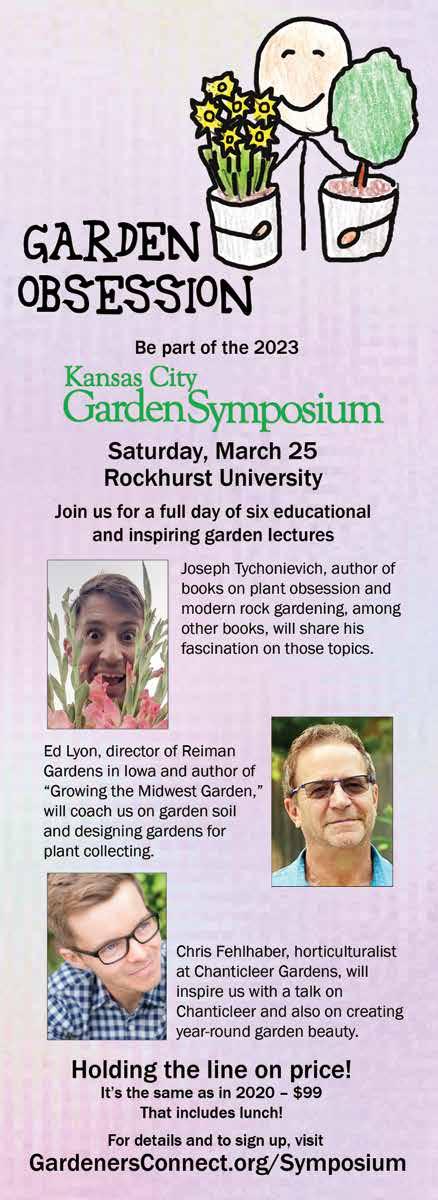


The Kansas City Gardener | March 2023 11
Migrants and Residents
Are you eagerly awaiting the arrival of spring butterflies? Wait no longer because most butterflies are already here! The Monarch’s spectacular migration receives so much publicity that most people assume that all butterflies migrate south in the fall. Not true, most butterflies are permanent residents. They and their offspring rarely venture further than 1⁄4 mile from their natal site unless they are swept away by our cruel Midwestern winds or are sad victims of habitat destruction. The exceptions to year-round residency are few: Monarchs, Sulphurs, Painted Ladies and
migrate north to lay eggs on members of the pea (clover) family. Red Admirals and Painted Ladies migrate to Arizona and New Mexico in fall. Their offspring head north in spring to nectar on early bloomers and search out Nettles to lay their eggs. We may even see Monarchs in late April, part of the northwardbound wave of generational migrants seeking Milkweed.
Scientists don’t yet know why the U.S. subpopulation of Monarchs migrates north in spring instead of remaining in their tropical home in Mexico. Wouldn’t that be easier? Unlike our native butterflies, they are unable to survive winter in the temperate zone so they must fly south in fall to survive. The southern fall flights are triggered by changing temperatures and length of daylight, not food supply. Monarch Watch assures us that their favorite food, Tropical Milkweed, does not affect the migration’s timing.
Resident Breeding Populations
your garden, you should see them every year. A resident butterfly is far more secure in your sanctuary than one that is looking for a habitat because even short journeys can be hazardous to a small aviator. Urban obstacles to travel include huge buildings, acres of concrete and air pollutants. Rapidly moving vehicles may be their chief predator!
Summary
Most insects hibernate rather than risk thousand-mile journeys
to complete their lifecycles. Even resident butterflies are at risk for the perils of travel if they are forced from the security of your garden by too much cleanliness or careless plant decisions. Beware of killing the overwintering stage, eradicating the host plants or removing native and/or heirloom flowers to install sterile hybrid flowers. If your residents are evicted, another gravid female must find your garden to establish her species all over again.
Establishing a Resident Breeding Population
Like Monarchs, Cloudless Sulphurs migrating each spring and fall depend upon nectar-rich flowers. But their caterpillars eat Sennas rather than Milkweeds.

Red Admirals. For the rest, you risk killing next year’s butterflies if you aggressively clean-up your garden. In early spring I hand-crumple and drop in place all debris not already broken down by Mother Nature, including twigs and branches. Nothing leaves my garden. Not only am I preserving my butterflies, native bees and fireflies, I don’t ever have to buy mulch.
Seasonal Butterfly Migration
Clouded Sulphurs, Orange
Sulphurs and Cloudless Sulphurs overwinter along the gulf coast. In spring and summer, their offspring
The definition of a butterfly garden is an area that supports resident breeding populations. That means all resources for the four stages of a butterfly’s life are present. For the eggs and caterpillars, the garden must contain the obligatory host plant for each desired species. Adult butterflies need an abundance of nectar-rich flowers from March to November’s killing frost. Caterpillars and adults require sheltering plants for nighttime repose, chrysalis formation and winter hideouts. Leaving a portion of your yard more natural with “weeds” and a wood pile meets these needs.
It only requires one gravid (“pregnant”) female of a species to establish a resident breeding colony if she finds her host plant in your yard and the subsequent offspring successfully go through their lifecycle to reproduce every year. Depending on the species, any stage may overwinter. Once a species of butterfly has established itself in
LENORA LARSON Butterfly Maven

In 1994 when I began butterfly gardening, I had never heard of a Pipevine Swallowtail, much less seen one. But my new butterfly book said that they lived in Kansas so I planted a Pipevine, Aristolochia macrophylla* and set vigil. Several years later I saw her, black with iridescent turquoise wings, laying eggs on my Pipevine. Voracious herds of gorgeous caterpillars followed and the rest is history. Fast forward 25 years and Pipevine Swallowtails are by far my most numerous butterfly. They have three broods each year so they fly in my garden from April to August and so many caterpillars are on my six Pipevines that I can hear them munching! They survive winter in their chrysalids slung by silk threads on stems and twigs. They are so well camouflaged that I rarely see them, but birds and rodents find them for winter snacks so every chrysalid is precious.
* Pipevines are rarely found at nurseries and plant sales. However, we will have two natives and the South American species at our Paola Plant Sale on April 27, 28, 29, 2023.

12 March 2023 | kcgmag.com
A Marais des Cygnes Master Gardener, Lenora is a member of the Idalia Butterfly Society and Kansas Native Plant Society. She gardens in the clay soil and cruel winds of Paola, KS. She may be contacted at lenora.longlips@gmail.com.
Photos by Lenora Larson.

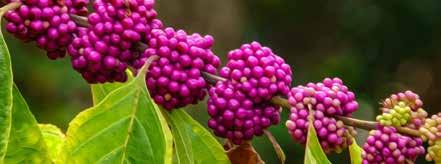


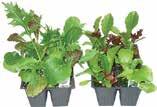





The Kansas City Gardener | March 2023 13 Earth Day Festival & Native Plant Sale Join us on Saturday, April 22, 2023, 10:00 AM-2:00 PM Metropolitan Community College–Longview Campus 500 SW Longview Rd, Lee’s Summit, MO 64081 Presented by: Planters Seed Co. • Since 1924 • Retail • Wholesale Lawn • Garden • Farm 513 Walnut, KCMO • 816-842-3651 Mon-Sat 8am-5pm, Sun 9am-3pm March Planting Dates Plant Above-Ground Crops: 1-3, 21, 24, 25, 28, 29 • Plant Root Crops: 9-13 Transplant: 1-3, 29, 30 • Plant Flowers: 2, 24-25, 28-29 • Control Plant Pests: 14, 15, 18, 19 Grass Seeds • Fertilizers • Mulches • Bulbs • Bird Supplies • Pottery Best Quality of “Locally Grown” Bird Seed! Flowers & Vegetable Seed – Largest Selection in the Area Potatoes, Onions, Herbs and Vegetable Plants arriving daily! 11711 Roe Avenue (NE corner 119th and Roe) • 913-491-4887 Hours: Mon-Sat 10am-6pm; Sun noon-4pm www.wbu.com/kansascity Follow us at www.facebook.com/wbuleawoodks BACKYARD BIRD FOODS • BIRD FEEDERS • BIRD HOUSES BIRD BATHS • GARDEN ACCENTS • NATURE-INSPIRED GIFTS Save $10 off $60 at the Leawood Wild Birds Unlimited In-store or online using promo code: BLUEBIRD.* JOIN OUR FLOCK If you’d love a discount everyday, we invite you to join our team! We are hiring for part time associates. Drop your resume at the Leawood WBU store. *One discount per purchase. Offer not valid on previous purchases, gift cards, DSC memberships or sale items. Offer valid March 1-31, 2023.
More Than a Pretty Face Plants with Purpose
When I started Missouri Wildflowers Nursery in 1984, few people were thinking about how the plants that they used in gardens were interacting with animal life in the area. They were more focused on the attractiveness of the plants. Today many people want to know how the plants that they are putting in their gardens contribute to the ecosystem. What pollinates their flowers. What eats their leaves, seeds and fruits.
When I started the nursery, I only did it with the idea that native plants needed a place to live, because the natural communities where they occurred were disappearing. It seemed logical that gardeners would enjoy growing native plants, especially the attractive ones. At that time, I wasn’t considering the value that natives have in supporting a web of living organisms.
In 2007, Douglas W. Tallamy published his book, Bringing Nature Home, How You Can Sustain Wildlife with Native Plants. It connected all the dots for me as to the real need for native plants on our properties and in our immediate environments, not just those preserved wildlands far away but our gardens, yards, roadsides, and more. Today his message is everywhere, promoting the use of native plants to sustain wildlife. Tallamy talks a lot about the connection between native plants, insects, and birds, pointing out that 96% of all birds feed their young insects, particularly the caterpillars. And the native insects must have native plants to feed on. His research shows that exotic plants from other continents are rarely used by native insects.

Not only are native plants workhorses for the environment, but
many are also a delight to see. As time passes more and more species that aren’t so showy, make it into the nursery trade because customer interests are expanding to more than appearance.
Gardeners frequently ask for plants with flowers that will feed hummingbirds, bees, or butterflies. They know about the declining bee and monarch butterfly populations. Host plants that moth and butterfly caterpillars feed on, are also in big demand. Gardeners grow the host plants because they and their children enjoy seeing the life cycle of these insects, they want to help a declining species like monarch butterflies, and they want to see more birds successfully nesting on their properties. If you want to help birds feed their young caterpillars, plant oaks, cherries, and willows. They are the top-ranking tree groups in terms of the numbers of different moth and butterfly caterpillars supported. Oaks host over 550 moth and butterfly species
The furor over native plants is high now, thanks a lot to social media. If you are new to the native plant idea, you might consider the
MERVIN WALLACE Natives Plantsman
“Missouri Native Plant Society” Facebook page, just one of many social media forums involved with native species. If you haven’t used any native plants that you know of in your gardens, this spring is a good time to start. Just plunk a few in and see what shows up. Chewed leaves are a welcome sight.
A few suggestions to consider for your garden
1. Red buckeye, Aesculus pavia, blooms within a few days of when hummingbirds arrive. The red tube-shaped flowers are almost exclusively pollinated by hummingbirds.

2. Showy goldenrod, Solidago speciosa, and other goldenrods are great at providing nectar for migrating monarchs. Many kinds of insects use goldenrods for nectar and pollen in fall.
3. Sullivant’s milkweed, Asclepias sullivantii, and other milkweed species are hosts to monarch butterfly caterpillars. Sullivant’s milkweed prefers full sun and average to moist soil.
4. Purple poppy mallow, Callirhoe involucrata, is a full sun species with sprawling stems. The plants can be 4 or 5 feet across, yet less than 6 inches high, and they will hang over landscape walls. Purple poppy mallow is pollinated by bees.
5. Dutchman’s Pipe Vine, Aristolochia tomentosa. Caterpillars of the pipevine swallowtail butterfly feed exclusively on Dutchman’s pipevine and one other Aristolochia species in Missouri.
6. Blue wild indigo, Baptisia australis, is in the pea or Legume family. It grows in full sun and well-drained soil. Blue indigos are usually pollinated by bumblebees.
7. Leather flower, Clematis versicolor, is a nice small vine that can climb over other plants or on a small trellis. We have had one in a large pot for 15 years. The flowers are pollinated by bees.
8. Indian pink, Spigelia marilandica, has attractive flowers and foliage. Flowers are in late May and June with the foliage lasting well into September. Indian pink is pollinated by hummingbirds.
9. Roundleaf Groundsel, Packera obovata, makes an excellent groundcover in part shade and average soil. The four-inch-high foliage is green through winter. Flowers in April and May.
10. Service berry, Amelanchier arborea, is a small tree that’s a great substitute for Bradford pears. The fruits are ripe in early June and are readily consumed by birds.
Mervin Wallace started Missouri Wildflowers Nursery in 1984. The nursery supplies propagated native species that have their genetic origin from within the state of Missouri. His activities are seasonal, doing plant sales in the spring and fall, harvesting wildflower seeds in summer and fall, and preparing the nursery’s catalog in winter. But that’s not all.
14 March 2023 | kcgmag.com
1









The Kansas City Gardener | March 2023 15 10 8 6 9 7 5 4 3 2
Photos by Mervin Wallace.
March Rose Report
It’s Time to Get The Roses Moved
If you are feeling spring is getting earlier every year, you are right! The European Union’s Copernicus Climate Change Service Report, published in January, shows that globally the last eight years have been the eight warmest on record. So, we need to pay close attention to weather reports and
how to transplant roses. Check it out at https://www.kansascityrosesociety.org, click on Rose Info and then Transplanting Roses. While on the website you may also want to start planning for new additions by using the Rose Library tab where you can find photos and descriptions of the varieties grown at the
there and to learn how to plant a bare root rose bush. For more information, go to kansascityrosesociety.org to attend in person or on Facebook Live.
No-Spray Rose Trials
Around the world, test gardens evaluate new varieties or roses en-
by Dr. David Zlesak from Wisconsin. It offers fragrance, very good disease resistance and is nearly thornless.
Petite Knock Out® was recently introduced as the first miniature Knock Out and is reported to be a non-fading red and useful in containers or garden groupings. List-

forecasts to determine when we get outside to start digging.
All garden plants need an inch of rain (or a foot of snow) each month during winter. One of our March activities might be to water on one of those nice warm days if our garden hasn’t received adequate moisture.
A good March task is to move any roses that need a new spot. Did any of your roses overgrow their territory or need more sun? Before much new growth gets started, this is a great time to make the transition. Roses are tough and can endure quite a bit of stress but moving now will allow them to break dormancy in their new home and get off to a good start.
The Kansas City Rose Society has a useful web page with tips on

Laura Conyers Smith Municipal Rose Garden. For any questions about growing roses, our Consulting Rosarians are ready to assist with a quick email to kcrosehelp@ gmail.com.
Free Spring Rose Program
Offered by KC Rose Society
Dr. Raymond Cloyd, Horticultural Entomology/Plant Protection Professor, Kansas State University will present “Aphids, Japanese Beetles, and Rose Midge: How to Identify and Control Rose Pests” at the Loose Park Garden Center on Saturday, March 25 at 10 a.m. After the program, all are encouraged to join Dana Flemming, Kansas City Parks Head Rosarian, in the Laura Conyers Smith Rose Garden to learn about organic products used

JERRY DREYER Consulting Rosarian
tering the market under different climate and growing conditions. Two national groups in the United States use a No-Spray Protocol to evaluate these roses’ disease and insect pressure susceptibility. Results reported by regions are helpful for us to evaluate how winners might perform in our area.
The American Rose Trials for Sustainability (A.R.T.S.®) divides our country by climate zones using the Köppen climate classification system which focuses on temperature and rainfall. Our area is in the light blue Dfa Climate Zone noted by a humid continental climate with a warm summer.
There are two regional Winners in 2023 for the Dfa Climate region. Pretty Polly® White is one of a series of three polyanthas hybridized

ings of other regional and past local winners can be found at www. TrustedRoses.com.
In the American Garden Rose Selections (AGRS™) testing program, Kansas and Missouri are in the South-Central Region.

This year OSO Easy® Urban Legend® was a winner in five regions including ours. This bright red landscape shrub shows off with contrasting yellow stamens. It is very disease resistant and has won many trial awards in the United States and United Kingdom.
A three-region winner that includes our region and was a Fragrance Award Winner, is Brindabella™ Pink Princess. This beauty was found as a sport of Brindabella™ Purple Prince which was bred in Australia and has also been
Moving up and down Interstate 35, Jerry Dreyer has grown roses over 10 years each in Iowa, Minnesota and Kansas. He is a Consulting Rosarian with the Kansas City Rose Society and American Rose Society. Hybridizing new roses is a special passion (or his wife asks, disorder?) along with experimenting with different propagation methods. Due to their most recent move to a shaded lot, he’s currently growing over 200 roses in pots.
16 March 2023 | kcgmag.com
Pretty Polly White Petite Knock Out
Brindabella Pink Princess OSO Easy Urban Legend
a previous multi-region winner. Brindabella Pink Princess grows to about 4 feet tall and wide, has a bushy growth habit, and has striking doubled, fragrant blooms.
The final South-Central Region winner was Petite Knock Out, described previously. More information and other winners are available at www.americangardenroseselections.com.
Another national No-Spray Protocol evaluation is the Earth-Kind® Trial led by Texas A&M University. To earn the Earth-Kind designation rose varieties must demonstrate superior pest and disease tolerance, combined with outstanding landscape performance. Although not all Earth-Kind cultivars are hardy in our area, more information can
be found at https://aggie-horticulture.tamu.edu/earthkindroses/ and select the Earth-Kind Roses Cultivars tab.
While the roses mentioned have scored well in these trials, we should not expect complete absence of fungal disease. For example, there are over a dozen races of blackspot alone around the United States, not to mention other fungal agents, so disease challenge varies by location. Horticulture practice, air circulation, companion plants and weather conditions are among a long list of other influences that affect plant health. These varieties join a growing list of disease resistant roses that allow nospray gardeners to enjoy the beauty of roses.
A Gardener’s Destination
Often Copied NEVER DUPLICATED ONE QUART COVERS 10,000 SQUARE FEET

Break Up Compacted and Clay Soil
Replenish Beneficial Microbes • Replace Micronutrients Drain Standing Water & Increase Water Utilization
Organic Micronutrients, Enzymes & Acids
Professional Strength Conditioner
Accept Only Original Earth Right Products for the health & beauty of your lawn & garden.
KEEP SOIL CLEAR OF SALTS USING SURE BLOOM


Feed Your Garden & Containers with SURE BLOOM NATURAL or 6-7-6

ONE QUART COVERS 10,000 SQUARE FEET
Use MUSHROOM STUFF to Establish Roots & Avoid Transplant Shock
1 QT covers 20,000 Sq Ft
MUSHROOM STUFF STIMULATES ROOT GROWTH USE FOR TURF, PLANTS, TREES, SHRUBS
MADE IN THE HEARTLAND!
To ship Sure Bloom®, Earth Right Super Stuff® & The Mushroom Stuff® see our website on where to order. To have Earth Right products applied at your location: Tobin Lawn & Landscape (816) 765-5565 or Big Green Turf Management (816) 600-4936.
Earth Right (913) 492-2992 or www.superlawnstuff.com

Dr. Raymond Cloyd, Professor at Kansas State University, will present information on Aphids, Japanese Beetles & Rose Midge: How to Identify & Control Rose Pests in the Loose Park Garden Center at the Laura Conyers Smith Rose Garden on 3/25 at 10 am. Afterwards you are invited to join Dana Flemming with KC Parks in the Garden to learn how to plant bare root roses & learn about the natural & organic products we use to help keep the garden beautiful.
Over 200 varieties of bulk seed, packaged seed from Renee’s Garden, Botanical Interest and many new varieties


Great selection of cool season vegetables
Kale, Lettuce, Broccoli, Swiss Chard, Brussels sprouts, Cauliflower, Cabbage, Spinach and more
Welcome early spring with pansies and violas and snapdragons. Cool season vegetables, seed potatoes, onion plants and sets, asparagus crowns, and strawberry plants. 112

Swan’s Water Gardens
Let

help you enjoy your water feature in 2023!
SPRING Cleanouts: In March, we start cleaning water features which will get you on the right track for maintaining your pond.
Monthly Maintenance: Don’t have the time to dedicate to maintaining your water feature? Our monthly maintenance programs will ensure your water feature remains in its best possible condition. Our maintenance team is knowledgeable and will cater to exactly what your water feature needs.
Other Services:
• Service calls. If you ever have a problem with your feature or landscape lighting, give us a call and one of our crew members will come out and fix it.
• Landscape lighting. AMP Lifetime Fixtures and Transformers.
• Hardscapes. Patios, walls, firepit, decks, and outdoor living.
• Full Retail Center. Pond/Lake maintenance products and equipment supplies, Koi and assorted goldfish, aquatic plants including lilies, lotus and marginals.
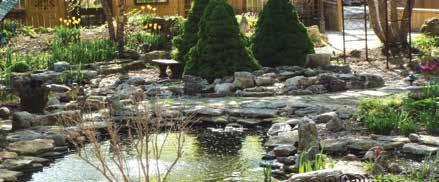

We’re going paperless!
Please
Living
The Kansas City Gardener | March 2023 17
and Loving The Water Garden Lifestyle! Email us: swanswatergardens@gmail.com Call us: 913-837-3510 Office hours: Mon-Fri 9a-2p www.swanswatergardens.com
4385 W 247th St, Louisburg, KS
Located:
us
stay up to date on all
contact us to guarantee you receive our emails to
our services for 2023!
E. Green St. • Clinton, MO 64735 660-885-3441 • Mon.-Fri. 8-6, Sat. 8-4
Our New Pond a collaboration for Grandview High School
Ponds can be permanent or temporary depending on their maintenance. At Grandview High School we have a courtyard that includes raised garden beds, trees, sculptures, benches and, of course, a pond. When our pond was constructed roughly 20 years ago, the vision of this pond was to have an outdoor learning environment where art classes could come to draw or English classes could come to write. However, our pond wasn’t kept up to its fullest potential.
This is where the Sustainable Living class stepped up to the table in order to renovate our pond to create the space that was intended for students to thrive in the environment around them. In Spring 2022, Robert Lowe of the Kansas City Water Garden Society came to visit our school to evaluate our pond that had fallen into disrepair. He took a look at what our pond needed and how we could perfect it.
At the start of this school year, the Sustainable Living 2 class placed the Courtyard pond as a top priority. On Oct. 3, Linda Harwood and Mr. Lowe came out to evaluate our pond for the second time.




They determined that our pond needed some serious work and decided to come back later that week to lead the rebuilding of our pond. With galoshes and waders on our sustainable living students, along with our teacher, Dana Bedwell, Lowe and Harwood got down into the pond and got to work. We all started pumping water out of the pond to clean out the muck and mire of the water garden.
This consisted of a lot of teamwork. We found out that the odor of stagnant water from our pond wasn’t very pleasant. After scooping out the duckweed and water lettuce by hand, we were able to rescue eight goldfish. Harwood took our fish to a rescue house so they could be reintroduced to our pond when it was cleaned and fixed.
There were a lot of issues surrounding the pond, including that one of the walls was about to collapse. On Oct. 17, we had a visit from Roye Dillion of Prestige One Landscaping and he quickly repaired the wall. Later that week, Lowe and Harwood returned to help us refill our pond and proceeded to release our original fish, with an addition of new koi fish, into our newly renovated pond.
In return for all of their much needed help, our class provided fresh salads from our raised beds to Harwood and Lowe. The salads included fresh lettuce, spinach, kale, beet greens, cilantro, tomatoes, mustard greens and arugula, all from our own garden.
Our pond renovation and harvest party was a collaborative effort from the Kansas City Water Garden Society, Prestige One Landscaping and the Kansas City Community Garden. We experienced a lot of difficulties with our pond earlier in the year, from it smelling very badly to all the duckweed sitting on top of it. With the gracious help of Robert Lowe and Linda Harwood our pond is well on its way to being a focal point in the Grandview High School Courtyard.
18 March 2023 | kcgmag.com


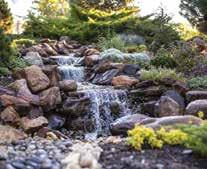



The Kansas City Gardener | March 2023 19 Design/Build • LED Lighting Pond Cleaning Services • Maintenence Repair - Leak Diagnosis • Winterization 816-560-0816 LoyalPond.com LoyalPond@gmail.com Our passion is water and providing an enjoyable outdoor oasis for our customers. GROW HAPPY PLANTS USE A CHUNKY MIX EXTRA AERATION • FAST DRAINING PEAT MOSS FREE View our products at solsoils.com. Ask for them at your local garden center. Use KCG20 for 20% off
Indoor Gardening: The Whole Plant
Generally, we grow our edible plants with one specific part of each variety in mind based on its unique culinary characteristics. Whether it’s the fruit of tomatoes, the leaves of lettuce, or the roots of carrots, we tend to cherish one component and discard or compost the rest (rightly so, in most cases, due to undesirable tastes and textures of the ancillary portions). There are, though, a handful of plants that can be grown with the WHOLE plant in mind; plants whose desirable qualities for consumption aren’t limited to one particular segment. Not to suggest that composting or repurposing plant material as animal feed is in any way a misuse, but there’s something special to me about a plant that we, as humans, can consume (and enjoy) in its entirety. A good case in point: radishes.
Part of the Brassicaceae Family that includes cabbage, broccoli, cauliflower, Brussels sprouts and mustards, radishes conjure images of round red or cylindrical white roots adorned with a handful of disposable foliage. Thinly julienned slices add a subtle heat to our salads. Matchsticked slivers enhance our sushi rolls, and pickled strands spice up our “not-so-street” tacos. But to ignore the rest of a radish plant is to do it a great disservice. In fact, a radish plant can be eaten far before the commonly-known edible root even begins to form.
After just a week or two from planting, seedlings known as “microgreens” can be harvested and enjoyed in salads, sandwiches, wraps, smoothies and more. They add a peppery taste, similar to the fully formed root, while also providing a massive boost of antioxidants, vitamins and minerals, including vitamin C, E and K. Because they are harvested so quickly after planting, they don’t require any fertilizer or nutrients. Every-
thing they need to reach harvesting height (approximately 2-3 inches) is already present in each seed. Fill a tray or plastic container with a thin layer of soil, no more than an inch or two deep. Cover the soil with radish seeds and then lightly sprinkle soil over top. Mist the top layer with water each day, and you’ll start to see sprouts popping through the surface in a few days. Light requirements are almost nonexistent, but a small grow light or well-lit windowsill will quickly turn the first embryonic leaves green. Within the blink of an eye, you’ll be ready to harvest, clipping clumps of fresh microgreens, just above the soil’s base.
Since the energy to sprout is already contained in the seeds themselves, soil isn’t a requirement to grow microgreens. Any type of grow media that can retain moisture and provide a foundation for young roots is more than sufficient – even wet paper towels will do the trick. Microgreen kits can be pur-

JASON MISPAGEL Indoor Gardener

chased that include trays to grow in, along with mats pre-loaded with seeds and enough mass to maintain root structures through harvest.
Allow sprouts to continue growing, and you’ll soon have an opportunity to harvest their leafy greens. But be aware, you’ll need more than a thin layer of soil and a seedling tray. Without space for roots to expand and readily available nutrition, foliage will struggle to develop. Grab a well-draining potting soil mix and pour it into a container that allows at least 6 inches of depth. Sow seeds just as you would for microgreens but thin them out for 2-3 inch spacing between plants. Keep soil moist but not oversaturated and hang a broad spectrum T5 fluorescent light around 6-12 inches above its surface. Within 2-3 weeks, young leaves, best eaten raw, will be ready to harvest. If allowed to mature too long, leaves will begin to develop small hairs that many find unpleasant to consume. However, there are varieties such as White Icicle, Per-
fecto and Red Head, whose leaves never develop these hairs. Why eat radish leaves? Just like their microgreen counterparts, they’re packed with nutrition: vitamin A, B1, B6, B9, C, calcium, potassium and iron.
As leaves mature above-ground, the traditional vision of a radish (a swollen tap root) is ripening under the surface. Four to five weeks from planting and radish roots will be ready for harvest, but there’s still one more opportunity to consume radishes that needs to be discussed – seeds.
Rather than harvesting the roots, allow your radishes to flower and pollinate each other. Each plant will produce both male and female flowers but is unable to pollinate itself. Therefore, hand pollinating from one plant to another or using an oscillating fan indoors will be necessary to fertilize female flowers. The result will be seeds that form in edible “pods” with all the flavor of the peppery roots and the crunch of a snap pea.
20 March 2023 | kcgmag.com
Jason Mispagel is the co-owner and operator of Year-Round Garden, a grower’s supply center serving both home and commercial customers since 2016. To contact Jason, call 816-216-6917 or jason@year-roundgarden.com.
Microgreens provide a massive boost of antioxidants, vitamins and minerals.
Burr Oak Woods Nature Center Native Plant Sale & Naturescaping Workship 1401 NW Park Rd, Blue Springs 64015. March 11 12:304:30 p.m. Workshop hours 8 - 12 a.m. 816-228-3766



Missouri Prairie Foundation Native Plant Sale at Anita B. Gorman Conservation Discovery Center, 4750 Troost Ave, Kansas City MO 64110. Saturday, April 15 & May 13, 10 a.m. to 2 p.m.
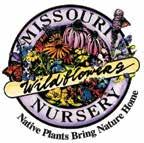
Deep Roots Native Plant Sale at Metropolitan Community College, Longview 500 SW Longview Rd, Lee’s Summit 64081. April 22, 10 a.m. to 2 p.m. deeprootskc.org

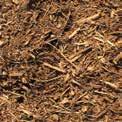



Native Plant Sale by Burroughs Audubon at 6212 NW Barry Rd. KC MO 64154. Backyard Bird Center 816-746-1113. Saturday, April 22, 10 a.m. to 2 p.m.

Shawnee Indian Mission Foundation - Native Plant Sale at 3403 W. 53rd St, Fairway KS 66205. Saturday, April 29, 9 a.m. to 2 p.m. shawneeindianmission.org



The Kansas City Gardener | March 2023 21 For All Seasons Lawn Food Plus Crabgrass and Weed Preventer Apply in early spring or fall 2 to 3 weeks prior to seed germination to obtain control of grassy and broadleaf weeds Coverage: 5,000 sq. ft. Make Your Neighbors GREEN WITH ENVY This Spring NOW AVAILABLE AT: Jacksons Greenhouse & Garden Center, Topeka v Doctors At the Lake, Lake of the Ozarks v Manns Lawn & Landscape, St. Joe v Gronis Hardware and Seed, Leavenworth v Clinton Parkway Nursery, Lawrence v Barnes Greenhouses, Trenton, MO v Soil Service Gdn. Center, Kansas City, MO v Loma Vista North, Kansas City, MO v Skinner Garden Store, Topeka v Full Features Nursery, Smithville v Springtime Garden Center, Lee’s Summit v Heartland Nursery, Kansas City, MO v Planter’s Seed, Kansas City, MO v Penrod’s Greenhouse, Kearney v North Star Garden Center, Liberty v Grimm’s Gardens, Atchison v Moffet Nursery, St. Joe v Suburban Lawn & Garden, Kansas City, MO BFG is the Leader in Green Industry Distribution www.greenleafkc.com 816.916.5171 GET READY FOR SPRING! • Update, Clean • On-going bed maintenance • Professional service Top Soil • Mulch • River Rock • Sand • Gravel Fireplace Materials • New & Used Brick • Pavers 9108 W. 57th Merriam, KS 66203 (1 blk E. of Merriam Dr.) Hrs: Mon.–Fri. 7am–4pm • Closed Sat. until April 913-432-8092 816-842-5012 • pondskc.com 1557 Swift Ave., KCMO Spring is coming soon! Fish and Pond Supplies for all your water garden needs! Come see us first for your pond liner needs. Great prices for both hobbyists and installers. Check our Facebook page for current winter hours. We serve the entire Kansas City metro! Welcome Lawrence Hobbyists. The metro’s Exclusive pond retailer Friendly personable knowledgeable service Missouri Wildflowers Nursery
fax:
mowldflrs@socket.net 9814
Meet us at one of these locations in the KC area. Give us your order by Tuesday before a sale, and we will bring it to the location.
573-496-3492,
573-496-3003 www.mowildflowers.net
Pleasant Hill Rd Jefferson City MO 65109
Upcoming Garden Events
Growing a Seed Garden and How to Save Seeds
Thurs, Mar 2, 11:30a-1p; the Sunflower Room at the Wyandotte County Extension Office, 1208 N 79th St, Kansas City, KS. Sponsored by the Wyandotte County Extension Master Gardeners; presented by Patti Ragsdale, Johnson County Master Naturalist. This class, free to the public, it will also be “simulcast” via Zoom for persons unable to attend in person. Email kckim0782@gmail.com for the link to register for Zoom.
Garden Club of Shawnee
Thurs, Mar 2, 7p; at Shawnee Town 1927 Town Hall, 11600 Johnson Dr, Shawnee, KS. We will have a K-State Extension Master Gardener talk about Growing Vegetables Successfully in Kansas. As always, we will serve drinks and snacks, and nifty door prizes will be given away. Visitors are welcome! Please visit our website gardenclubofshawnee.org and our Facebook page for more information. Our Thurs, Apr 6 meeting speaker will be a K-State Extension Master Gardener who will talk about Colorful Shade Gardening: Beyond Hostas.
Orchid Delirium
March 3-April 16, at Powell Gardens. See all the details at powellgardens.org.
Water Gardening – Mini to Magnificent
Sat, Mar 4, 8:30a-3:30p; in the Flory Building on the 4-H Fairgrounds, 2120 Harper St, Lawrence, KS. Check-in and refreshments will be 8:30 to 9, first session 9 to 11:30, lunch on your own, and second session 1 to 3:30. Sponsored by Douglas County Extension Master Gardeners, this free, one-day onsite workshop is the culmination of a generous donation by the former Lawrence Water Garden Society. The workshop will be given by Kelly Billing, an international aquatic plant specialist, water garden designer, consultant and author with over 35 years’ experience in the water garden industry. Kelly compiled and currently maintains the regulated aquatic plant list in the U.S. and has served on the board of directors for the International Waterlily and Water Garden Society. Registration is required for one or both sessions. The workshop is free but registration prior to the event is required as space is limited. To register, please sign up at: https://dgemgks.com/ advanced-education-programs/.
Raytown Garden Club
Tues, Mar 7, 10a; at Connection Point Church in Raytown, MO. Our program will be “Preparing for a Flower and Horticulture Show” by Jo Ready, club member and accredited Flower Show judge. Guests are always welcome. For More information please check out our Facebook page: https://www.facebook.com/ RaytownGardenClub
Leavenworth County Master Gardeners
Wed, Mar 8, 11a; at Riverfront Community Center, 123 Esplanade St, Leavenworth, KS 66048. Rob Wunder will present “Fungi, Gardens and Your Sphere of Health.” Learn what a mushroom is and how they can impact one’s garden, diet and health. Rob is a lifelong outdoorsman, Eagle Scout, Missouri Master Naturalist, Vice-president and Foray Chair of the Kansas City Chapter of the Missouri Mycological Society and is Certified: Leave No Trace and Wild Mushroom Harvester. The meeting is free. Visitors are welcome. For more information contact the Leavenworth County Extension office at 913-364-5700.
Sho-Me African Violet Club
Fri, Mar 10, 11a-1p; at Jacob L Loose Park Garden Center, 51st and Wornall, Kansas City, MO. Visitors Welcome.
Healthy Yards Expo
Sat, Mar 11, 9a-2p; at Shawnee Civic Centre, 13817 Johnson Dr, Shawnee, KS. Local businesses, non-profits, city and county departments will offer seminars and tips helping make greener choices. Johnson County residents get one free soil test, compliments of Johnson County Stormwater Management and Johnson County K-State Extension. For more information on the Healthy Yard Expo, visit www.johnson.k-state.edu or call 913715-7000. This is a free event.
Idalia Butterfly Society
Sat, Mar 11, 5p; at Matt Ross Community Center, 8101 Marty St, Overland Park, KS 66204. Doors open at 5p; beverages and light snacks will be served. Meeting begins at 5:45 PM with the program immediately following a brief session of business and announcements. Julie Copley, Powell Gardens Conservationist, will present “The Prairie Puzzle: Complex Relationships on the Prairie Landscape.” Our most endangered Midwestern ecosystem is also one of our most mysterious and least understood. Explore the interactions between soil, fire, animals and plants that sustain this unique habitat and the effects of fragmentation on its diverse web of life. The meeting is free; visitors are welcome. Call/text 816-795-8177 with any questions.
Heartland Hosta & Shade Plant Society
Sat, Mar 18, Check-in and Hospitality starts at 9:30a, meeting at 10a; at Community of Christ Church, 500 NE Woods Chapel Rd, Lee’s Summit, MO 64064. Guest speakers Mike and Susan Weber will present the four seasons of Conifers and Woodie ornamentals and their landscape compatibility with Hosta and shade perennials. They will present photos of their 1-acre Champaign, IL property where they have gardened for 38 years. With the help of handouts, Susan
will illustrate and explain basic design elements of their garden. Mike will detail how they complement their shade perennial cultivars as well as the basics of conifer collecting, growing and why conifers offer year-round seasonal interest in the home garden. Visitors are welcome.
Douglas County Master Gardeners Presentation
Sat, Mar 18, 10:15a; at 2110 Harper St in the 4-H Family Dreher Building, Lawrence, KS. Presentation subject—TBD. Come and join the Douglas County Extension Master Gardeners for one of their presentations that are free and open to the public. These talks are a wonderful opportunity to get out and learn something new. We offer informative talks on a diverse variety of subjects.
Olathe Garden & Civic Club
Tues, Mar 21, 1-2:30p; at K-State Extension, 11811 S Sunset Dr, Room #1060, Olathe, KS. Free to attend and open to the public. Club membership not required. Please join us for our monthly club meeting and presentation from Master Gardener Bob Lane, “Common Garden Mistakes.”
African Violet Club of Greater Kansas City
Fri, Mar 24, 11a-1p; at Jacob L Loose Park Garden Center, 51st and Wornall, Kansas City, MO. Visitors Welcome.
Flower, Home & Garden Show
Sat, Mar 25, 10a-4p; at Heritage Event & Arts Center, 109 Delaware St, Leavenworth, KS. Join us for a fun-filled and informative event! Show features flowers, plants, home décor and garden equipment. Admission: $2 per person. Leavenworth County Master Gardeners will be making presentations throughout the event. www.heritagecenter-leavenworth. com; 913-682-2122
Garden Obsession | Kansas City Garden Symposium
Sat, Mar 25, Rockhurst University. The Kansas City Garden Symposium presented by Gardeners Connect is one of the premier gardening events in the region. We bring to the stage the best in local, regional and national garden experts and talent to educate and inspire gardeners of all skill levels. “Garden Obsession” is all about the gardens and plants that entice, beguile and make gardeners obsess. Three speakers. Six presentations. Lunch. Gift bag. A day of gardening delight you won’t want to miss. For details and to sign up, visit GardenersConnect. org/symposium.
Kansas City Rose Society
Sat, Mar 25, 10am; at the Loose Park Garden Center. “Aphids, Japanese Beetles, and Rose Midge: How to Identify and
Control Rose Pests,” by Dr. Raymond A. Cloyd: Professor and Extension Specialist in Horticultural Entomology/Plant Protection, Department of Entomology, Kansas State University (Manhattan, KS). After the program, all are encouraged to join Dana Flemming, KC Parks Landscape Technician/Head Rosarian, in the Laura Conyers Smith Rose Garden to learn about the organic products used there and to learn how to plant a bare root rose bush. For more information, go to kanascityrosesociety.org to attend in person or on FaceBook Live.
Leawood Garden Club
Tues, Mar 28, 10:30a; at Cure of Ars Catholic Church, 9401 Mission Rd, Leawood, KS 66206. Horticulture Hints: “Spring is in the Air! What’s Next?” Our Annual Fund-Raising Auction held by the Auction Committee. Our Annual, fabulous and fun silent auction is one more way of supporting our altruistic endeavors. The auction committee works hard to obtain a wide variety of auction items. There will be gift cards from restaurants, service providers, nurseries and lawn companies. We will have live plants and planters plus gift baskets and more. You can participate by donating an item to the auction and/or bidding on the auction items. *Checks and cash can be used as payment for the purchased auction items.
Plants and Garden Related Items SALE
Sat, Apr 15, 9a-noon; at East Parking Lot at St Bernadette Church, 9020 E 51st Terr, Kansas City, MO. Spring is the time to beautify your gardens with plants and gently used garden art and tools. Come and enjoy a treat from our bake sale while you shop. Cash only please.
Earth Day Festival & Native Plant Sale
Sat, Apr 22, 10a-2p; at Metropolitan Community College–Longview Campus, 500 SW Longview Rd, Lee’s Summit, MO. Presented by Deep Roots & GaleHart Communities. Add beauty and function to your garden with plants that support pollinators, birds, butterflies, and more!
Paola Spring Plant Sale
Apr 27, 28, 29, in the parking lot at the K-State Extension Office, 913 N Pearl (Old KC Road), Paola, KS. Thursday 9 to 5, Friday 9 to 6, and Saturday 9 to 1. The sale will feature pesticide-free locally grown plants. In addition to the usual selection of butterfly host plants, pollinator flowers and native perennials, there will be ornamental annuals, perennials, herbs, succulents, hanging baskets, trees and veggies. Extension Master Gardeners, including butterfly expert Lenora Larson, will be on hand to assist shoppers throughout the sale. Credit Cards welcome! More info at www.maraisdescygnes.ksu.edu. Follow us on Facebook at
22 March 2023 | kcgmag.com
www.facebook.com/mdcemg or call the office: 913-294-4306.
Sho-Me African Violet Club 37th
Annual AVSA Judged Show and Sale: “Zodiac Days”

Sat, Apr 29, 9a-3p; at Jacob L Loose Park Garden Center, 51st and Wornall, Kansas City, MO 64112. No Admission Fee.
Uptown Garden Faire
Sat, Apr 29, 8a-2p; at 211 W Truman Rd, Independence, MO 64050. Celebrate Arbor Day and Spring at the Garden Faire and Market with food, giveaways, and raffles. Plants, gardenalia, plantiques, garden art, and much more for sale by local vendors. For more information call 816-797-8711 or 816-325-7843.
American Conifer Society Central Region Conference & Speaker Series
Jun 2-3, at the DoubleTree by Hilton Conference Center, 10100 College Blvd, Overland Park, KS. Kansas City is hosting the annual Conference and Speaker Series, making this a great opportunity for local members and their guests to enjoy the gardens, speakers, unique auction conifers and camaraderie for which the ACS Central Region is so well known. The Conference (Fri 4p - Sat 10p) features keynote speaker Panayoti Kelaidis (Denver Botanic Gardens) on Friday evening, coach buses to four beautiful conifer gardens on Saturday, four meals, plus one-of-a-kind conifer auctions. An optional Speaker Series (Fri 8a - 2p) features three presentations and lunch. The theme of the Speaker Series is ‘Conifers and Companion Hobbies’ featuring Brian Boyce, Kathy Schlesinger and Ken Wood. For schedule, garden and speaker descriptions, and to register, please visit https://conifersociety.org/news-events/ event/2023-central-region-annual-meeting/

Hermann, Missouri 28th Annual Town and Country Garden Tour
Jun 3-4. The Garden Tour includes both a walking tour of gardens in downtown Historic Hermann and a driving tour to gardens in the hills around Hermann. The $15 ticket price includes visits to at least four private gardens; these gardens are both in town and in the country and include a traditional four-square garden. Garden Tour visits may be spread over Saturday and Sunday. Tickets will be sold online before the tour at Eventeny and at Topiaries (138 E 4th) in downtown Hermann during the tour from 10-5 on Saturday and 10-3 on Sunday. Gardens close at 5p on Saturday and 4p on Sunday. A map to the gardens will be provided starting on Saturday June 3 at the Topiaries ticket sale site. The Hermann Garden Club’s website www.hermanngardentours.com provides up-to-date events, ticket prices, links to the online ticket sale site, contact numbers, and photographs of past tour gardens. A special new event, The Garden Club High-End Estate Sale, will begin at 10am on Friday at the Rotunda in Upper City Park and continue until 6pm. There will be a preview from 3-6pm on Thursday; tickets for the preview are $10. Visit the FAQS page on the website for answers to all your questions. “Like”
us on Facebook at “Hermann Garden Tours.” Go to www.visithermann.com to find information about lodging. The Garden Tour is always the first full weekend in June.
Save the Date for Garden Tour!
After a four year hiatus, the Garden Club of Shawnee will be hosting its poplar Garden Sampler Tour. Mark your calendar for June 10, 2023 and make plans to view five unique neighborhood gardens
in Shawnee. This year’s tour features gardens exhibiting creative ideas for extended outdoor family living areas, childfriendly play areas in whimsical themes and gardens specializing in organic gardening. Bring your cameras to capture plant identities, as well as great planting combos and techniques. Enjoy walking in woodlands and relaxing along water gardens and streams. Take your time, sit among the birds and butterflies...the gardens are open 9am to 5pm...rain or shine.
Tour tickets can soon be purchased for $15 each at www.thegardenclubofshawnee, and various gardening outlets. Or if you prefer to buy tickets in advance, at EventBrite.com (a small additional fee will be applied).
Promote plant sales, club meetings, classes, and other gardening events for FREE!

Send details to: elizabeth@kcgmag.com.
Deadline for publishing in the April issue is March 5.
The Kansas City Gardener | March 2023 23
• Learn soil pH • Save money on fertilizers • Decrease runoff that can pollute our waterway In partnership together Funding for this free offer courtesy of Johnson County Stormwater Management. It all starts with a soil test! Johnson County residents get one FREE soil test. Learn how: go to johnson.k-state.edu or call 913.715.7000. Why can’t I get my tomatoes to grow? Johnson County
Healthy Yards Expo promotes green lawn and garden practices
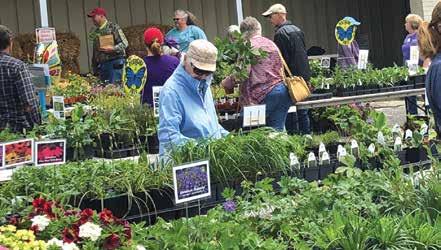
Plant Sale in Paola
Save the last weekend in April!
The annual plant sale in Paola will again feature locally grown plants, raised without the use of pesticides so the plants are safe for butterflies and bees. Also, they are compatible with our local weather conditions and soil.
are just hungry. In the case of bees, their larvae also depend on flowers for food since they are fed regurgitated nectar and pollen. Butterflies, syrphid flies and honey bees are not picky about their flower choices so we will have ornamental, na-
The Eleventh Healthy Yards Expo on Saturday, March 11, can help you make greener choices for your yards and homes. This free Earthfriendly lawn, garden, and home event is from 9 a.m. to 2 p.m. at the Shawnee Civic Centre, located at 13817 Johnson Drive in Shawnee. The expo is free to attend.
The expo highlights many simple and easy environmentally friendly practices that can be done to achieve a lovely landscape. Johnson County K-State Research and Extension have teamed up with Johnson County Stormwater Management and the cities of Overland Park, Lenexa, Olathe, Shawnee, and the Unified Government of Wyandotte County to present the event.
Local businesses, non-profits, and city and county departments will offer seminars and tips to help you make greener choices.
“The expo promotes eco-friendly practices and provides education so that you can do your part for clean water, air, and healthy soils while maintaining an attractive landscape,” said Dennis Patton, horticulture agent for Johnson County Extension.
Visitors to the Expo can:
• Enter to win door prizes
– such as rain barrels and compost bins.
• Get a free tree seedling (while supplies last).
• Talk with city representa-
tives to discover what’s happening in your neighborhood and learn about cost-share programs for establishing rain gardens and rain barrels.
• Listen to informative speakers on native plants, composting, organic gardening, and edible landscaping.
• Kids can enjoy a free performance by Stone Lion Puppet Theatre with their show, The Little Red Hen.
• Visit with Johnson County K-State Research and Extension Master Gardeners and local plant societies for expert advice on gardening and plant cultivation.
• Shop our Native Plant Sale! Choose from locally grown plants selected to thrive in your garden.
Free soil tests
Knowing your soil nutrient levels to grow healthy plants and protect the water quality in our local streams and lakes is important. Johnson County residents get one free soil test, compliments of Johnson County Stormwater Management and Johnson County K-State Extension. Bring your soil sample to the expo. Learn how to take an adequate soil sample by visiting our website.
For more information on the Healthy Yard Expo, visit www. johnson.k-state.edu or call 913715-7000.
Extension Master Gardeners will be on-hand to answer your questions with expertise ranging from flowers to vegetable growing to butterfly gardening and bee-keeping. Credit Cards welcome!
The Largest Selection of Butterfly Host Plants in the Midwest
You choose which butterflies grace your garden by which caterpillar host plants you offer so we will have 40 species of host plants. This includes 8 species of Milkweed, focusing on natives and the Monarch’s preference, Tropical Milkweed Asclepias curassavica
Do not fear, fall migration is initiated by temperature drop and length of day, not food supply! Other host plants will include three species of Pipevines for Pipevine Swallowtails, four species of Senna for the Sulphurs and five species from the Carrot family for Black Swallowtails. We will also carry Rue, surprisingly a member of the Citrus family, but the Giant Swallowtail knows that. Native woody host plants will include Wisteria, Paw Paws, Tulip Trees and shrubs such as Lead Plant, Indigo Bush and Wild Indigo.
Nectar-Rich Flowers for Pollinators
Pollinators don’t know that they are vital to plant reproduction, they
tive and nativar perennials, as well as annual nectar-rich ornamental plants. Since about 30% of our native bees require a specific genus or species, we also offer a wide diversity of sun-loving native flowering plants, which will optimize your pollinator garden’s impact.
And So Much More
In addition to the usual selections of native and ornamental perennials, we will feature herbs, succulents, grasses and hanging baskets. Shade-loving selections include Heuchera, ferns and woodland flowers. Edibles will focus on carefully selected varieties of vegetable transplants, fruit trees and berry canes. Greg Beverlin will be onsite offering his hand-made hypertufa containers.
Convenient Location and Times
The sale is in the parking lot at the K-State Extension Office, 913 N Pearl (Old KC Road), Paola, KS. The sale will open promptly at 9 am. On Thursday April 27, we will be open until 5 pm. On Friday April 28, we’ll stay open until 6 pm and close at 1 pm on Saturday, April 29. Pay by cash, check or credit card. For more information go to www. maraisdescygnes.ksu.edu or follow us on Facebook at www.facebook. com/mdcemg or call the office: 913-294-4306.
24 March 2023 | kcgmag.com
& StoneLion an Earth-friendly
home, lawn and garden event
A wonderful diversity of plants and shoppers








The Kansas City Gardener | March 2023 25 www.arnoldsgreenhouse.com info@arnoldsgreenhouse.com (620) 964-2463 • 1430 Hwy 58, LeRoy, KS 66857 We open March 1st! Hours • 9am-5pm Mon-Sat Review our plant list and dream about spring! Follow us on Facebook! #NeedMoreFlowers Bringing glorious living color to your garden since 1977. 816-483-0908 | missouriorganic.com Top Soils • Pulverized Top Soil • Custom Soil Mixes • Garden Soil • Raised Bed Soil • Green Roof Soil Blends • Rain Garden Soil Blends Compost • NatureWiseTM • Green FrontierTM • Composted Forest Products • Composted Pine Fines Services • Sudden Gardens Consultation • Soil, Compost and Mulch Delivery and Installation Mulch • Premium I • Colored Mulches (red, brown & black) • Cedar • Hardwood Chips • Erosion Stabilization Get Our “Abby Guarantee”! You’ll find all of our quality products in bulk or bags at all of our locations. Also look for our bagged mulch at Sutherland’s Lumber. When you buy 3 or more yards of our Raised Bed Soil + The Growing MOR Nutrient Pack, we guarantee your growing success, or we’ll give you your money back on your plants. (Up to $200. Restrictions will apply.) 5 locations to serve you Soil RestorationTM • JustCharTM Growing MOR Nutrient PackTM Try Our High-Quality Soil Amendments – for 30 years –$25 off Nature WiseTM Compost 3 or more yards for 30 years 6979 WEST 75TH STREET OVERLAND PARK, KS HOURS: MON-SAT 10A-5P | CLOSED SUN 913•341•0700 WildBirdHouseStore.com Find us on Facebook! LARGEST SELECTION of wild bird supplies in the KC area, including bird seed, feeders, houses and hardware. 816•924•4924 4480 SOUTH NOLAND RD INDEPENDENCE, MO HOURS: MON-SAT 10A-5P | CLOSED SUN Family-owned & operated since 1990. Finch love sunflower and nyjer! FLOWER, HOME & GARDEN SHOW Saturday, March 25, 2023 10 a.m.–4 p.m. Heritage Event & Arts Center • 109 Delaware St, Leavenworth, KS 66048 (913) 682-2122 • www.heritagecenter-leavenworth.com Admission $2 per person Join us for a fun-filled and informative event! Show features flowers, plants, home décor and garden equipment. Leavenworth County Master Gardeners will be making presentations throughout the event. Join us and enter to win 50/50 Raffle and Door Prizes
GARDEN CALENDAR
March list of what to do in the garden.
LAWNS
• Spot-treat for dandelions, henbit, chickweed, and other weeds. Spot spraying reduces the amount of chemicals used and reduces drift. Use larger droplets and spray lower to the ground. Note that early spring weeds are also a source of pollen and nectar for pollinators.
• Apply crabgrass controls in late March through mid-April.
• Seed thin areas in bluegrass and tall fescue lawns.
• Missed fall fertilization of bluegrass and tall fescue? If so, apply nutrients with crabgrass control.
• Avoid March fertilization if fall fertilizer is applied, as it increases weed pressure and weakens grass reserves. It also creates excessive top growth and more mowing.
• Lower mowing height by about 2 inches to remove winter debris, do not scalp. Raise back up to at least 3 inches for summer health.
• Take a soil test to determine fertility needs. Nitrogen, the first number on the bag, is usually all that is required.
• Tune-up lawn mowers for another season.
• Sharpen mower blades for a quality cut.
TREES AND SHRUBS
• Delay pruning birch, maple, and walnut trees until they leaf out. They tend to ooze sap if pruned too early.
• Prune spring flowering shrubs soon after bloom.
• Prune summer-blooming shrubs now for excellent flowering.
• Mulch trees and shrubs plantings up to 3 inches deep, keep mulch away from trunks.
• Fertilize trees and shrubs.
• Plant new trees in the landscape.
• Remove tree wraps from young trees for summer growth.
• Rake and clean ground cover planting.
FLOWERS
• Plant pansies, snapdragons, calendulas, osteospermum, and other cool-loving annuals.

• Pollinator-friendly gardening delays spring cleanup until temps are consistently in the 50s.
• Prepare soil for annual planting by adding organic matter such as compost.
• Fertilize gardens based on soil test needs, typically nitrogen-only sources.
• Take a soil test if one has not been done in the last five years.
• Start seeds under lights indoors for transplanting to the garden.
• Remove winter mulch from roses and prune as needed.
• Cut ornamental grasses back within 3 to 5 inches of the ground.
• Plant new roses.
• Divide and plant perennials.
• Fertilize spring flowering bulbs such as tulips and daffodils.
• Remove seed heads from spent bulbs. Don’t remove foliage until it yellows naturally.
• Help control iris borers by destroying old foliage before new growth begins.
• Unwrap mail-order plants. Keep cool and moist until planting.
VEGETABLES AND FRUITS
• Prepare soil for spring planting.
• Take a soil test.
• Fertilize the garden before planting based on soil test results, as typically only nitrogen is needed.
• Plant broccoli, cauliflower, and cabbage in late March.
• Plant potatoes, peas, onions, lettuce, and other salad crops.
• Asparagus, rhubarb, and strawberries can be planted.
• Start transplants from seed for tomatoes, peppers, and other warm-season vegetables.
• Sharpen garden tools and repair.
• Apply dormant oil to fruit plantings to reduce scale and mite insects.
• Control peach leaf curl before growth begins.
• Prune fruit plantings, fruit trees, grapes, raspberries, and blackberries.
• Remove mulch from strawberries when growth begins.
• Turn the compost pile.
HOUSEPLANTS
• Fertilize to encourage rapid spring and summer growth.
• Repot crowded plants in a 1-inch larger pot.
• Shape plants by pruning and trimming.
• Remove winter dust from leaves with a damp cloth or place it in a warm shower.
• Check for insects.
• Start cuttings of plants.
WATER QUALITY PROTECTION
• Keep grass clippings off the street. Sweep or blow back into the lawn.
• Keep fallen leaves off the street. Rake and use as mulch or in compost.
• Direct downspouts onto grassy areas for absorption, reducing runoff.
• Sweep granular fertilizers and pesticides from hard surfaces back onto the lawn.
• Prevent soil erosion. Mulch bare soil areas.
• Pick up pet waste.
Johnson County K-State Research and Extension recommends environmentally-friendly gardening practices. This starts by identifying and monitoring problems. Cultural practices and controls are the best approach for a healthy garden. If needed, use physical, biological or chemical controls. Always consider the least toxic approach first. Dennis Patton is the horticulture agent for Johnson County K-State Research and Extension. For free information fact sheets, visit www.johnson.ksu.edu, or call the Extension office at 913-715-7000.

26 March 2023 | kcgmag.com
University of Missouri Extension Master Gardeners of Greater Kansas City is conducting a summer gardening program for youth ages 9-13. In the Garden ’N Grow Program, youths learn not only vegetable gardening, but also “cultivate” other science, math, and language arts skills and have fun! The goals of this program are to experience the fun of gardening, to enjoy a feeling of success, and to have the satisfaction of sharing harvested food with family and/or local food banks.
The development of the whole child is emphasized as well as team building as they garden. Master Gardeners use cooperative teaching skills to educate youth about seeds, transplants, garden planning and design, site preparation, soils, plant growth and development, costs of production, garden pests, plant health care, human nutrition, food value, food needs in the local community, and horticultural career opportunities. Each Master Gardener is trained by University of Missouri Extension specialists.
The Garden ’N Grow Program will be held on Mondays and Thursdays from 9:00-11:00 a.m. from June 5 through August 10 at Fairview Christian in Gladstone. Registration is required—NO Walk-ins. There is a supply fee of $45 payable by check or cash at the first week of Garden ’N Grow. The supply fee includes a student workbooks, games and crafts, and some vegetable garden supplies.
For more information on the program contact Debbie Johnson at djw603@gmail.com or Cass Sullivan, Extension Master Gardener at jsull5@juno.com.
Hotlines for Gardeners


Extension
CASS COUNTY
816-380-8494; Wed, 9am-noon
DOUGLAS COUNTY
785-843-7058; dgcogardenhotline@gmail.com; Mon, Wed, Fri, 1-4pm
GREATER KANSAS CITY MISSOURI AREA
816-833-8733 (TREE); Mon-Fri, 9am-noon; mggkc.hotline@gmail.com
JOHNSON COUNTY, KS
913-715-7050; Mon-Fri, 9am-4pm; garden.help@jocogov.org
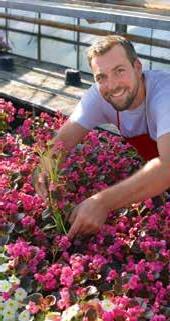
JOHNSON COUNTY, MO
660-747-3193; Wed, 9am-noon

LEAVENWORTH COUNTY
913-364-5700; Leave a message. A Master Gardener will contact you.
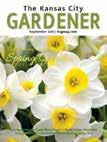


MIAMI COUNTY & LINN COUNTY
913-294-4306; Thurs, 8am-noon
WYANDOTTE COUNTY
913-299-9300; Mon, Wed, Fri, 9am-4pm
QUESTIONS ABOUT ROSES?
For
The Kansas City
The Kansas City Gardener | March 2023 27
Ask a Rosarian; kcrosehelp@gmail.com; www.kansascityrosesociety.org Master Gardeners are ready to answer your gardening questions.
Name: Address: City, State, Zip: Phone: E-mail: Where did you pick up
Gardener?
enclose your check payable to The Kansas City Gardener and mail with this form to: P.O. Box 8725, Prairie Village, KS 66208 The Kansas City Gardener is published monthly Jan. through Dec.
convenient mail delivery,
the form below and send with your check for $35.00. You will receive a oneyear subscription. SUBSCRIBE TODAY To see a full list of openings, visit suburbanlg.com/employment/ Now Hiring Service Division, Retail Stores, and Growing Division 3 Easy Ways to Apply Now Email resume By Text suburban@suburbanlg.com 13600 Wyandotte, KC MO In Person Questions? Call Human Resources 816-941-4700
Please
complete
Summer Youth Gardening Program
What Will
You Grow?
If you’ve never started seeds indoors, why not give it a try? It’s a great way to get a jump start on your veggie garden or fill in flower beds on a budget.

If you’ve never started seeds indoors, we have kits that make it a breeze. We stock all the supplies you’ll need to start the season including peat pots, pellets, and trays.
And, of course, we carry a great selection of seeds.


is Better Our Mulch

• Made locally, made by us
• Safe for people and pets because only non-toxic mineral-based colorants are used
• Available in bulk or bags, even free delivery with minimum purchase
28 March 2023 | kcgmag.com
Pictured: “Jump Up” series Violas
Come Color in for the No matter the weather outside, our greenhouses have rainbows inside. Visit us after March 3rd to drink in the color from pansies, ranunculus, flowering kale, snapdragons, stock, dianthus, alyssum and more!
suburbanlg.com K-7 & Prairie Star Pkwy (913) 897-5100 135th & Wornall (816) 942-2921 105th & Roe (913) 649-8700






































































































































